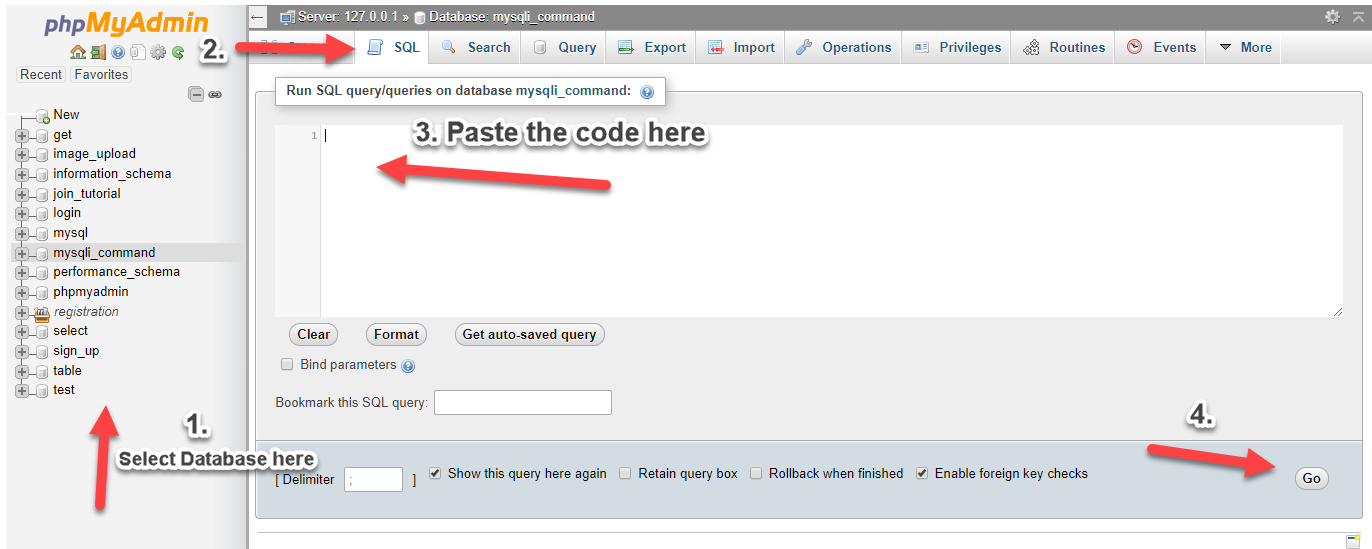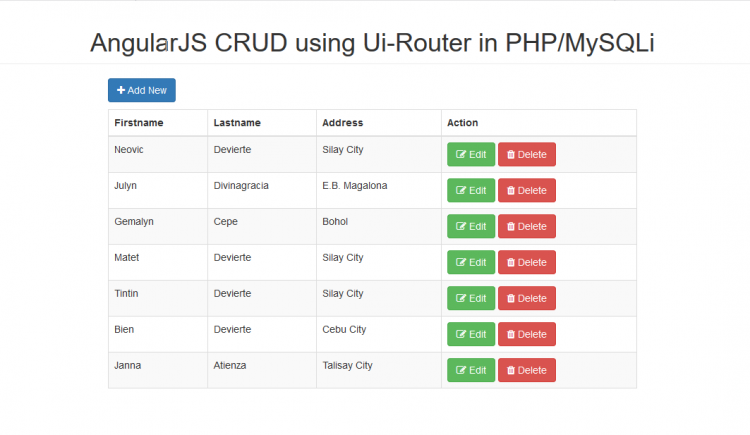Creating an AngularJS CRUD using UI-Router and PHP/MySQLi Tutorial
This tutorial tackles on how to create a CRUD Operation in Angular JS using Ui-Router to manage our routes and PHP/MySQLi to handle our backend with MySQL as our Database. You will learn in this tutorial how to use UI-Router. Angular JS is a javascript framework maintained by Google and is capable of creating Single-Page Applications.
Getting Started
I've used CDN for Bootstrap, Angular JS, and Ui-Router so you need an internet connection for them to work.
Creating our Database
First, we're going to create our MySQL database.
- Open
phpMyAdmin - Click databases, create a database and name it as
angular - After creating a database, click the
SQLand paste the below codes. See image below for detailed instruction.

Creating the Interface
This is the main view of our app and the place where we declare all our dependencies. Save the file as index.html
- <!DOCTYPE html>
- <html lang="en" ng-app="app">
- <head>
- <meta charset="utf-8">
- <link href="https://maxcdn.bootstrapcdn.com/bootstrap/3.3.7/css/bootstrap.min.css" rel="stylesheet">
- <link href="https://maxcdn.bootstrapcdn.com/font-awesome/4.7.0/css/font-awesome.min.css" rel="stylesheet">
- </head>
- <body>
- <div class="container">
- <!-- this is where we render our view -->
- </div>
- <!-- main script -->
- <!-- controllers -->
- <!-- services -->
- </body>
- </html>
Creating the Angular Scripts
Note: In this Tutorial I compiled all the angular files and directories in the single folder naming js.
app.js
This is the main angular script of our app.
- var app = angular.module('app', ['ui.router']);
- app.config(function($stateProvider, $urlRouterProvider) {
- $urlRouterProvider.otherwise('/home');
- $stateProvider
- .state('home', {
- url: '/home',
- templateUrl: 'partials/home.html',
- controller: 'homeCtrl'
- })
- .state('add', {
- url: '/add',
- templateUrl: 'partials/add.html',
- controller: 'addCtrl'
- })
- .state('edit', {
- url: '/edit/{member:json}',
- templateUrl: 'partials/edit.html',
- controller: 'editCtrl'
- })
- .state('delete', {
- url: '/delete/{member:json}',
- templateUrl: 'partials/delete.html',
- controller: 'deleteCtrl'
- })
- });
services/memberService.js
This is the service that we created to handle our members and request.
- 'use strict';
- app.factory('memberService', function($http){
- return{
- read: function(){
- var read = $http.get('api/read.php');
- return read;
- },
- create: function(member){
- var add = $http.post('api/add.php', member);
- return add;
- },
- update: function(member){
- var edit = $http.post('api/edit.php', member);
- return edit;
- },
- delete: function(member){
- var del = $http.post('api/delete.php', member);
- return del;
- }
- }
- });
controller/homeController.js
This is our controller for home.html.
- 'use strict';
- app.controller('homeCtrl', ['$scope', 'memberService', function($scope, memberService){
- //fetch members
- $scope.fetch = function(){
- var members = memberService.read();
- members.then(function(response){
- $scope.members = response.data;
- });
- }
- }]);
controller/addController.js
This the controller for our add.html.
- 'use strict';
- app.controller('addCtrl', ['$scope', 'memberService', '$location', function($scope, memberService, $location){
- $scope.error = false;
- //add member
- $scope.add = function(){
- var addmember = memberService.create($scope.member);
- addmember.then(function(response){
- if(response.data.error){
- $scope.error = true;
- $scope.message = response.data.message;
- }
- else{
- console.log(response);
- $location.path('home');
- }
- });
- }
- }]);
controller/editController.js
This is our controller for edit.html.
- 'use strict';
- app.controller('editCtrl', ['$scope', 'memberService', '$location', '$stateParams', function($scope, memberService, $location, $stateParams){
- $scope.error = false;
- $scope.updatedmember = $stateParams.member;
- //edit member
- $scope.update = function(){
- var updatemember = memberService.update($scope.updatedmember);
- updatemember.then(function(response){
- console.log(response);
- if(response.data.error){
- $scope.error = true;
- $scope.message = response.data.message;
- }
- else{
- console.log(response);
- $location.path('home');
- }
- });
- }
- }]);
controller/deleteController.js
This is our controller for delete.html.
- 'use strict';
- app.controller('deleteCtrl', ['$scope', 'memberService', '$location', '$stateParams', function($scope, memberService, $location, $stateParams){
- $scope.error = false;
- $scope.deletemember = $stateParams.member;
- //delete member
- $scope.delete = function(){
- var dmember = memberService.delete($scope.deletemember);
- dmember.then(function(response){
- if(response.data.error){
- $scope.error = true;
- $scope.message = response.data.message;
- }
- else{
- console.log(response);
- $location.path('home');
- }
- });
- }
- }]);
Creating the Interfaces
Note: I compiled the following files inside partials folder.
home.html
As per our ui-router, this is considered to be our index view.
add.html
This contains the add new form.
- <div class="row">
- <div class="col-sm-4 col-sm-offset-4">
- <div class="alert alert-danger text-center" ng-show="error">
- </div>
- <div class="panel panel-default">
- <div class="panel-body">
- <div class="form-group">
- <input type="text" class="form-control" ng-model="member.firstname">
- </div>
- <div class="form-group">
- <input type="text" class="form-control" ng-model="member.lastname">
- </div>
- <div class="form-group">
- <input type="text" class="form-control" ng-model="member.address">
- </div>
- </div>
- </div>
- </div>
- </div>
edit.html
This contains our edit form.
- <div class="row">
- <div class="col-sm-4 col-sm-offset-4">
- <div class="alert alert-danger text-center" ng-show="error">
- </div>
- <div class="panel panel-default">
- <div class="panel-body">
- <div class="form-group">
- <input type="text" class="form-control" ng-model="updatedmember.firstname">
- </div>
- <div class="form-group">
- <input type="text" class="form-control" ng-model="updatedmember.lastname">
- </div>
- <div class="form-group">
- <input type="text" class="form-control" ng-model="updatedmember.address">
- </div>
- </div>
- </div>
- </div>
- </div>
delete.html
This is delete confirmation view.
Creating the PHP API Scripts
Note: I compiled the following files inside api folder.
read.html
This is our PHP API the fetches data from our database.
- <?php
- $conn = new mysqli('localhost', 'root', '', 'angular');
- $sql = "SELECT * FROM members";
- $query=$conn->query($sql);
- while($row=$query->fetch_array()){
- $out[] = $row;
- }
- ?>
add.html
Our PHP API that adds new data to our database.
- <?php
- $conn = new mysqli('localhost', 'root', '', 'angular');
- $firstname = $data->firstname;
- $lastname = $data->lastname;
- $address = $data->address;
- $out['firstname'] = true;
- $out['message'] = 'Firstname is required';
- }
- $out['lastname'] = true;
- $out['message'] = 'Lastname is required';
- }
- $out['address'] = true;
- $out['message'] = 'Address is required';
- }
- else{
- $sql = "INSERT INTO members (firstname, lastname, address) VALUES ('$firstname', '$lastname', '$address')";
- $query = $conn->query($sql);
- if($query){
- $out['message'] = 'Member Added Successfully';
- }
- else{
- $out['error'] = true;
- $out['message'] = 'Cannot Add Member';
- }
- }
- ?>
edit.html
Our PHP API updates our selected data.
- <?php
- $conn = new mysqli('localhost', 'root', '', 'angular');
- $firstname = $data->firstname;
- $lastname = $data->lastname;
- $address = $data->address;
- $memid = $data->memid;
- $sql = "UPDATE members SET firstname = '$firstname', lastname = '$lastname', address = '$address' WHERE memid = '$memid'";
- $query = $conn->query($sql);
- if($query){
- $out['message'] = 'Member updated Successfully';
- }
- else{
- $out['error'] = true;
- $out['message'] = 'Cannot update Member';
- }
- ?>
delete.html
Lastly, this is our PHP API that deletes our selected data.
- <?php
- $conn = new mysqli('localhost', 'root', '', 'angular');
- $memid = $data->memid;
- $sql = "DELETE FROM members WHERE memid = '$memid'";
- $query = $conn->query($sql);
- if($query){
- $out['message'] = 'Member deleted Successfully';
- }
- else{
- $out['error'] = true;
- $out['message'] = 'Cannot delete Member';
- }
- ?>
DEMO
That's it! You can now test the Simple CRUD Web App using Angular JS and PHP in your browser. I hope this tutorial will help you to understand how to create a CRUD application in Angular JS and PHP and also for your future Web Application projects.
Explore more on this website for more Tutorials and Free Source Codes.
Happy Coding :)Note: Due to the size or complexity of this submission, the author has submitted it as a .zip file to shorten your download time. After downloading it, you will need a program like Winzip to decompress it.
Virus note: All files are scanned once-a-day by SourceCodester.com for viruses, but new viruses come out every day, so no prevention program can catch 100% of them.
FOR YOUR OWN SAFETY, PLEASE:
1. Re-scan downloaded files using your personal virus checker before using it.
2. NEVER, EVER run compiled files (.exe's, .ocx's, .dll's etc.)--only run source code.

